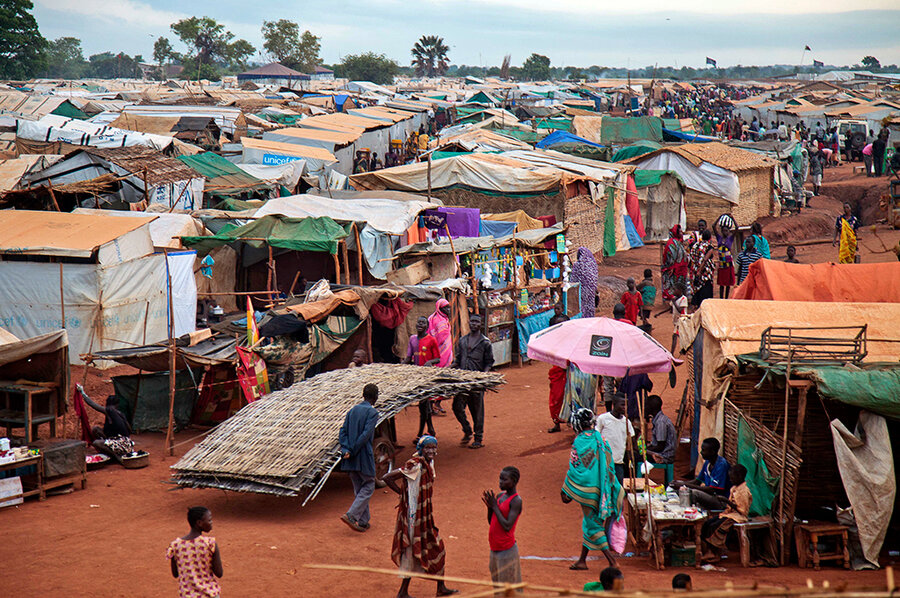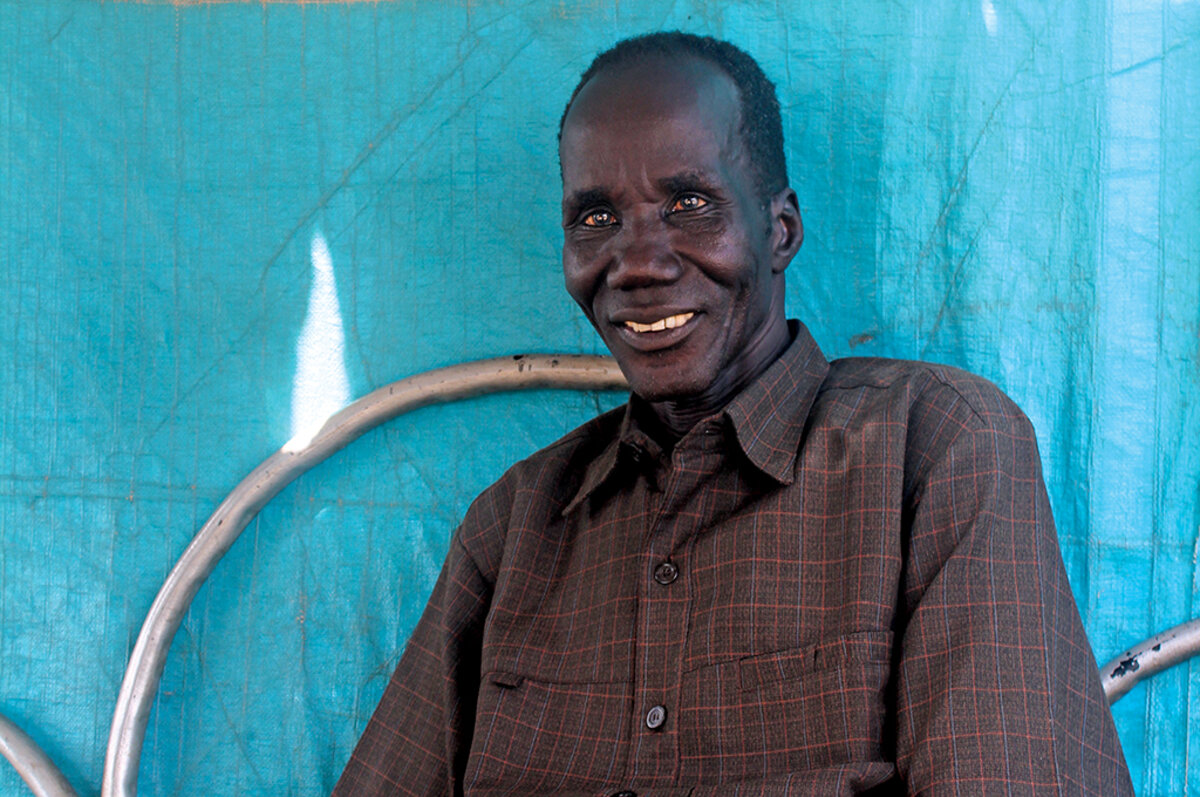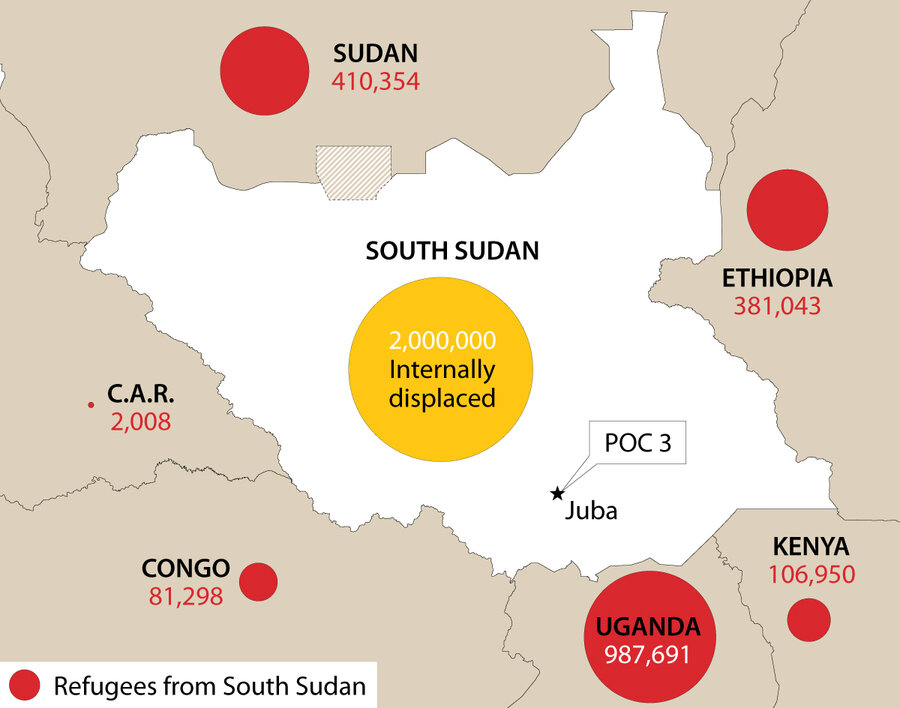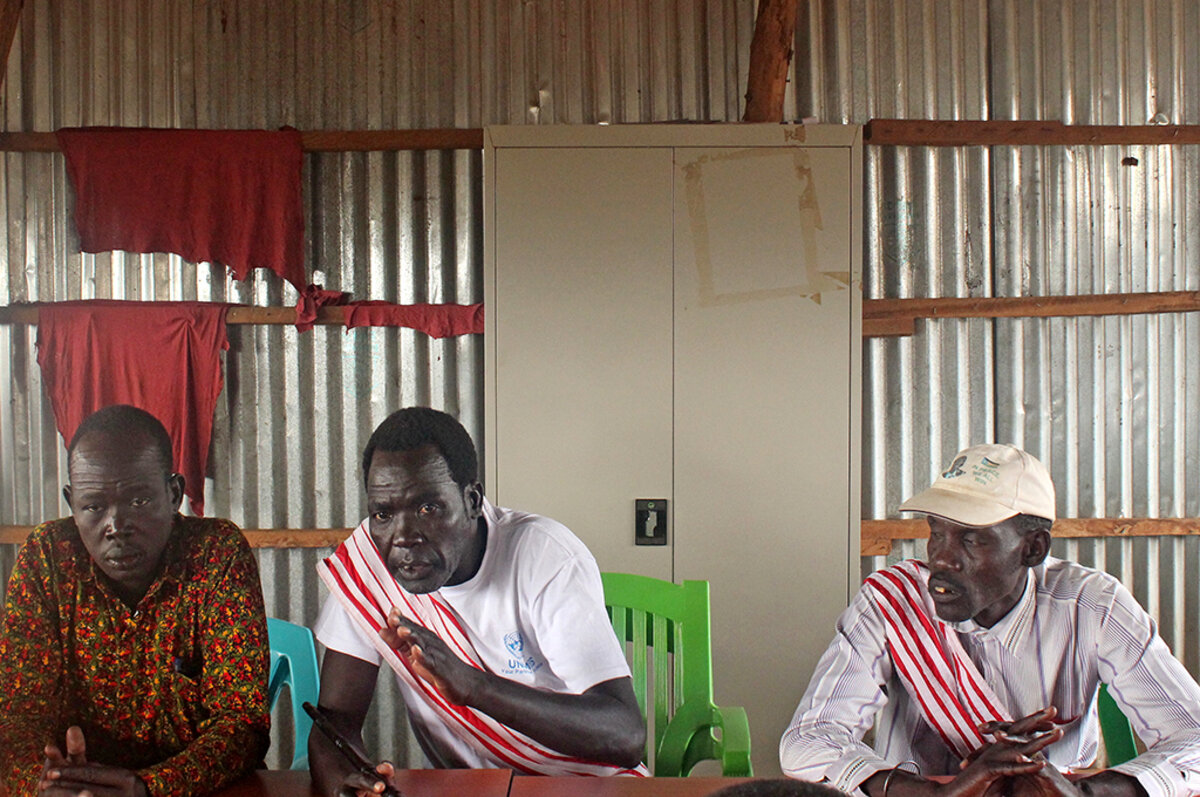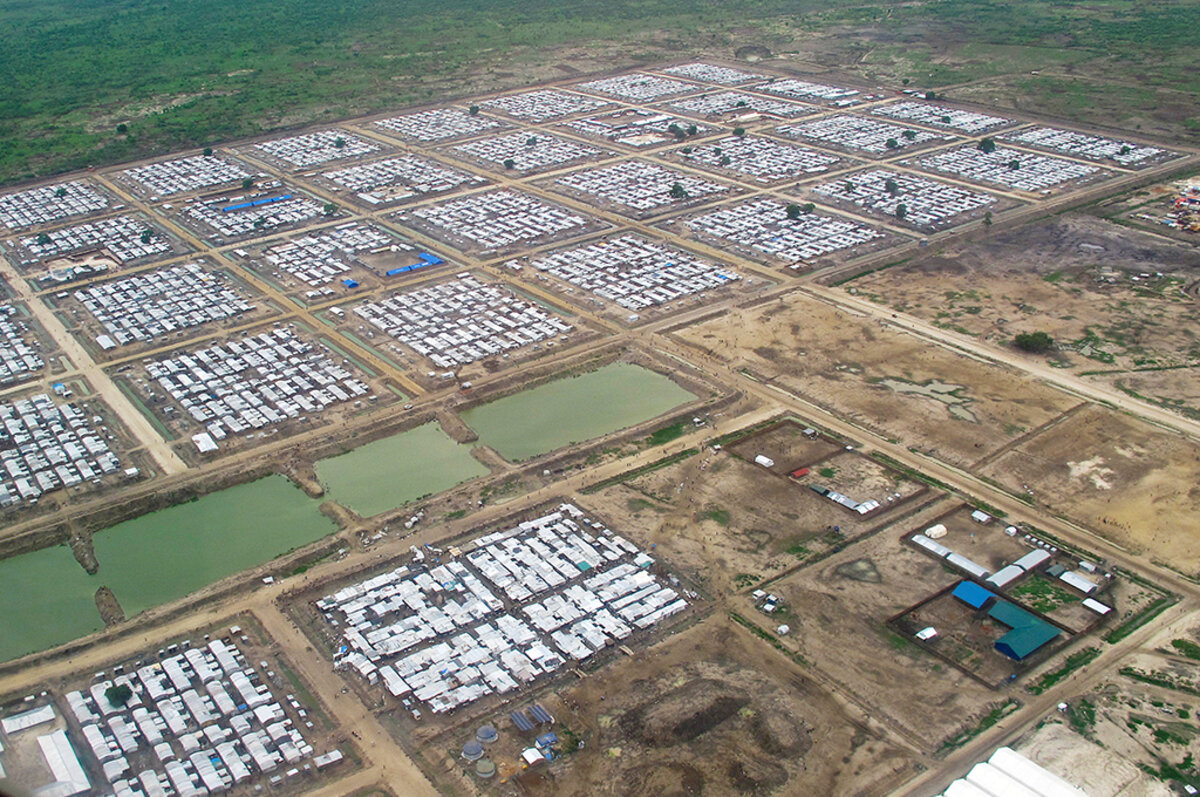Canvas cities: Does the world need a new model for refugee camps?
Loading...
| JUBA, SOUTH SUDAN
To find the movie theater in this sprawling camp for people fleeing war, take a right at the main gate, past the knot of police in full riot gear stealing bored glances at their cellphones. Go right again at the sentry tower made of shipping containers stacked up like a giant Jenga game, and then once more just past the water tap.
There, the road opens into a wide, dusty boulevard lined with tented shops. The movie theater is a few shops in, wedged between a tea stall, a vegetable market, and a large furniture store.
As far as cinemas go, it’s a bit cramped and more than a bit overheated, but what it lacks in facilities it makes up for with the omnivorous taste of its proprietor. Some days he screens a double feature of American professional wrestling and a Hollywood horror flick. Others it’s syrupy romances or wobbly livestreams of British soccer matches. Today, the movie is “Saving Private Ryan” cranked to a volume so loud the whole tent vibrates.
Four years ago, this area with the cinema and the entire tent city that surrounds it was nothing but an empty field backing up against a United Nations base on the edge of South Sudan’s capital city.
Then came civil war: a power struggle between the president and his deputy turned suddenly bloody. In the span of a single week in December 2013, about 30,000 people showed up on the UN’s doorstep here, begging for protection. Eventually, more than 200,000 people would take refuge in UN compounds countrywide.
At first the agency guessed that the new arrivals wouldn’t stay long – a few days, maybe a week or two, just until the fighting fizzled. But as the conflict deepened, the UN and international humanitarian groups found themselves in a familiar mode: plotting the architecture of a settlement for people with nowhere to go. First came the rows of identical tents spilling across the desert, then the blocks of shared toilets and the fenced-off clearings for food distribution.
Soon, however, the temporary camps were morphing into something else – functioning cities, messy and improvised, but unmistakably urban. Inside Juba’s Protection of Civilians (POC) Camp 3, as the main displaced persons settlement here is called, there are police stations and restaurants, 12 churches and a mosque, an internal economy with its own thriving real estate market, and even hints of gentrification.
The evolution of sites like this one highlights a broader trend worldwide: Displaced people want to live in cities – places with services and a sense of permanence – and they will cobble them together from whatever they are given. But that presents a quandary to humanitarians. The very idea of a camp – as the name suggests – is as a temporary refuge, a place to be set up and torn down again. After all, everyone wants displaced people to go home; making long-term plans for housing and governance implies they never will.
“We face a real dilemma,” says Ian Ridley, head of the UN Office for the Coordination of Humanitarian Affairs in South Sudan. “If we publicly verbalize that the [camps] are there to stay, then they will be there to stay, because then we’re saying that we don’t see any solution to the conflict.”
By the UN’s count, the world has some 65 million displaced people, the highest number since World War II. Many of those, including millions of South Sudanese, are fleeing conflicts with little immediate hope of resolution, which means returning home is, at best, a distant possibility.
Meanwhile, the organic transformation of many refugee settlements from flimsy camps to DIY cities has begun to push aid groups and governments to think more closely about one of the world’s most pressing humanitarian questions: What do you do with the millions of people who have no place to return to?
In Juba and the Jordanian desert, in rural Kenya and huddled along the Syrian border in southeast Turkey, displaced people themselves are offering one simple if imperfect solution: building lives – and places to live – that look more like the ones they left behind.
Displacement is a global crisis, but in few countries is it so existential as in the world’s newest nation. South Sudan was born in July 2011, cleaved off from Sudan, then Africa’s largest country, after decades of war. The conflict had left it with few schools, roads, or functional health centers. Then, just two years later, the infant nation turned on itself as factions loyal to the two political rivals tried to vanquish the other. The war that began in Juba radiated across the country.
Some civilians fled their homes and hid out in tropical forests, grasslands, and nearly impenetrable swampland. Others crossed into Uganda, Ethiopia, and even Sudan, their onetime enemy.
John Tot Malual, a doctor, sought refuge here, a few miles outside the capital. He fled on the second day of fighting in Juba, barely stopping to padlock the doors to his small private clinic before he ran to the UN compound. “The medicines, the beds, the laboratory, my whole working life, I left it there,” he says. “The only thing we could save then was our lives.”
Today nearly 4 million people, one-third of the population, have fled their homes. The fighting goes on, punctuated by inconclusive peace talks. The country has become so hollowed out that even if the war ended tomorrow, many of the displaced people would have nowhere to return to. And while few humanitarians have acknowledged the emerging reality of long-term displacement, for those who have fled it is already a reality.
“It’s been almost five years. I don’t expect to go outside anytime soon,” says Nyeruop Beliew Chuol, who heads a women’s committee in POC 3. “We are like cows in a pen. You only know the things inside.”
And inside that pen, she says, life must go on. “There is no movement right now that can bring peace,” she says. “So we take care of our own affairs.”
Fleeing from war did, for a moment, flatten social divisions here, rendering everyone equally helpless, equally in need. But soon, old social structures reemerged. Village elders became camp leaders. Gangs of former soldiers and militiamen formed community policing groups. Local courts began trying local crimes like adultery or having a child out of wedlock.
“These are not rabbits you’re putting in cages. These are people aching to get back to their normal life, trying to reclaim their individuality,” says Kilian Kleinschmidt, a former UN official who has managed refugee camps in Africa and the Middle East.
Ironically, life in the camps seems to have removed the biggest barrier to good government in South Sudan – war. While there are regional disputes here, the deeply held ethnic resentments cracking the country apart are mostly absent (in part because its residents, largely loyal to the opposition, are mostly of the same ethnic background). And no one’s salaries are being siphoned off by conflict, corruption, or economic collapse – because no one here makes a salary at all.
“We feel as people affected by war we have to at least be committed to peace here, in our camps,” says James Lam Gatluak, a judge.
On a recent morning, Mr. Gatluak and six other justices on the high court, the camp’s equivalent of a Supreme Court, sit at a plastic table in the corner of a tin building that serves as POC 3’s administrative headquarters. As they huddle over a skillfully forged American $100 bill, the face of a small child appears at the window, hushed and curious about the proceedings inside.
“I took this money from the bank,” says the defendant, a slight woman in a long yellow dress, waving a pink deposit slip from a bank in Juba. Her voice wavers with exasperation. “How can it be fake?”
The man accusing her of passing the counterfeit bill interrupts her testimony and slams his fist on the table. “She switched the bill and gave me that one,” he says. The judges, who each wear a red-and-white sash, quietly take notes.
Each month, the high court hears appeals from a network of 16 lower courts in the camp, about cases ranging from assault and theft to adultery. Most are settled at this table by the judges, who often mete out small fines, which the defendants pay to victims and camp administrators. Only four or five cases a month – murder, rape, or violent robbery – are referred to the UN. Judges weigh referrals carefully, since the accused could end up being sent to a prison in Juba, under the writ of the very government they fled.
Today, as the case of the fraudulent bill rambles on – there are hours of more witnesses and evidence to be heard – a flurry of angry voices rises from outside. Two residents march another man toward the local police station, a three-room tent. The suspect, who has been accused of beating up a man who eloped with his sister, rails against his captors, screaming obscenities.
In the next room over, Tek Chan explains how policing works in POC 3. “We follow human rights,” he says. “We have been taught by the UN about international law.” Just then, in the room where the prisoner is being held, a whip cracks on bare skin. A man wails, and then the room falls silent.
At times, however, “you need a local intervention,” says Mr. Chan, who heads a policing committee. The whip cracks again. He shrugs.
From above, camps like POC 3 look like a refugee Levittown: row after row of nearly identical tents laid out in a perfect grid. In theory, everything residents need here is free of charge, and everyone is treated the same. Food, education, medical care, a place to sleep – none of it costs a cent, and everyone is equally entitled to his or her share.
Camp life also comes with certain rules. No weapons. No alcohol. No leaving the compound after dark. Guards check residents coming from the outside for contraband – alcohol and drugs, of course, but also bricks and mortar. No permanent housing can be built here.
“The message has to go out that this is a temporary, interim solution,” says Charles Okwir, a relief, reintegration, and protection officer with the UN Mission in South Sudan. “It should not be seen as a permanent feature of life in South Sudan.”
But in recent years, its wealthiest residents have begun quietly replacing their UN-issued tents with circular huts made from mud bricks and twigs – taking advantage of a gray area in the “no permanent housing” rule – and filling them with furniture from local stores.
And despite the sameness of circumstances here, camp life is also entrepreneurial. People trade sacks of World Food Program corn for braids of dried fish that taste like meals back home, or they swap a load of firewood for a beaded bracelet. Ration cards are exchanged for hard currency, which pays for a better-located tent or a haircut, a pair of sneakers, a hunk of meat.
The natural impulse to turn temporary settlements into something more permanent is as old as civilization – and isn’t necessarily bad, according to Mr. Kleinschmidt. For thousands of years, he points out, humans have been running, searching – and resettling. Take Venice, the Italian city of canals and hordes of gondola-riding tourists. It began as a camp for civilians fleeing Germanic and Hun invaders after the fall of Rome.
“All our cities are refugee cities, in a way,” says Kleinschmidt. “So if you look at it that way, then why are we now making so much fuss about camps and depriving people from moving on with their lives?”
The answer to that question lies partly in the ruins of postwar Europe. In 1951, the newly minted UN laid down the first set of guidelines for how to treat people displaced by war. The UN’s refugee convention, which has since been adopted worldwide, sets out the rules on who is allowed to flee – people with a “well-founded fear of being persecuted” at home – and the obligation of receiving countries to provide “temporary protection” until a more durable solution is found.
That protection usually takes the form of a tented camp – cheap, flexible, and portable. The idea is that people will stay there until the conflict ends, or, if it doesn’t, they will either integrate into the new country or relocate to a third nation. In practice, long-term solutions have proved elusive. Many governments haven’t wanted to keep the refugees stranded in their country, and camps provide a simple, if inelegant, solution. So the life span of many of these ephemeral tent cities has ballooned, even as planning for them remains hostage to the idea that they will never be permanent.
In recent decades, cracks in the postwar model have begun to show. One after another, refugee “situations” have begun to sprawl across decades: Afghans in Pakistan, Sahrawis in Algeria, Burmese in Thailand, Sudanese in Chad. The number of people displaced inside their own countries has been ticking up, too, putting an added burden on governments and aid organizations.
Dozens of Palestinian refugee camps are now more than a half-century old. In Zaatari, a sprawling settlement of 85,000 Syrians in the Jordanian desert, locals have become so entrenched that they have set up their own pizza delivery services, travel agencies, and a system for addresses that UN authorities have hustled to replicate.
Many of the quarter-million people shoehorned into Dadaab, a cluster of camps on the Kenyan border with Somalia, have lived there since the early 1990s. Residents have coined a term to describe this kind of dragged-out displacement – buufis, the feeling of being forever in-between.
Buufis is “a kind of depression rooted in an inextinguishable hope for a life elsewhere,” said former Human Rights Watch researcher Ben Rawlence in his book on Dadaab, “City of Thorns.” People in these camps have finished school, gotten married, raised children, opened businesses. But for many, something important was missing – a sense that this was a place they could stay forever. Dadaab had, instead, become for hundreds of thousands of people a passageway sealed off at one end – a place leading to a future they could never see.
One way around this sense of limbo, some argue, is to locate refugee settlements in new areas and integrate them into local economies – rather than setting them up as, essentially, holding stations. The theory is that people want to live in cities anyway.
“People, not just migrants, but people generally, are urbanizing rapidly,” says Michael Castle Miller, executive director of Refugee Cities, a group of experts pushing for new forms of urban refugee settlement. “That makes sense because you find freedom in a city – freedom from poverty, from a lack of opportunity. There’s generally more prosperity in the city than the country.”
For Mr. Castle Miller and his team, one solution is to persuade host governments to build “special status” settlements for refugees in urban areas. Under this model, businesses could be given tax breaks in exchange for employing migrants.
But others want to create settlements that are more permanent from the outset by, among other things, having urban planners instead of humanitarians lay out the compounds. “If urban planners could plan camps in more sustainable places, then they could become thriving cities,” says Justin Tata, head of the department of architecture and urban planning at the University of Juba. The needs of a city – such as infrastructure and sustainable sources of water, electricity, and food – are often quite different from the needs of a temporary camp.
But building cities, even if they do end up being temporary, is a better solution because they tap into the countries they’re part of, whereas camps tend to leach off them – and off the international community. A more permanent refugee city, for instance, could charge residents to use electricity or piped water. A camp, on the other hand, might siphon electricity illegally from the grid, or draw water from trucks brought in at great cost by aid groups.
Still, others worry that if refugee camps become too comfortable, it will undermine efforts to end the conflict that gave birth to them in the first place.
In Algeria, about 165,000 Sahrawi refugees from Western Sahara, a disputed territory claimed by Morocco, have lived since 1975 in self-governing camps that have evolved over the years to look much like cities – albeit poor ones. Without obvious suffering or hunger there, many activists say it’s hard to persuade the international community to pressure Morocco into letting the refugees go home.
“Is there a long-term plan [for refugee camps] at the moment? No. Does there need to be planning? Yes,” says Mr. Ridley, head of the UN’s humanitarian coordination body in South Sudan. “The reason that long-term plan hasn’t existed is that we’ve hoped, of course, that people would be able to leave and go home.”
Bang Lul is one who would echo that sentiment – that people need to go home. For a dozen years, Mr. Lul lived with his wife and children in a refugee camp in Ethiopia, waiting for the end of Sudan’s civil war. When independence from Sudan was declared in 2011, they rejoiced.
Two years later, he headed back to Juba to start a new life. But before he could summon the rest of his family, fighting broke out, and he fled here. Now he’s waiting again. “If peace comes, we will leave tomorrow, but peace is not coming,” says Lul, a former chairman of POC 3.
Outside his tent, women haggle over exchanging bags of grain for spears of purple-green okra. An orange motorized rickshaw with a massive speaker pulls to a stop nearby. It’s a mobile radio station that travels the camp airing news, public service announcements, and personal messages. There’s a blast of music and then a man’s voice comes on, low and serious.
“Hello, Mary. It’s your brother. I’m greeting you. I’m well here in Zone 6, POC 3. Reply here when you hear this message.”
Back in the camp’s main office, the high court judges are preparing their ruling in the fraud case. After a trip to the bank in Juba, they have determined that the woman must have replaced the genuine banknote with a fake bill and passed it off to the man. She must pay him back and reimburse the court for damages. As the ruling is read out, her eyes fill with tears.
With the sun setting, the judges gather their things to go home. A new shift of men arrives, meanwhile, to begin a nightly neighborhood patrol. Nearby, groups of women and children, new arrivals who have not yet been assigned ration cards or tents, lay out mats on the dirt outside.
The night settles in quietly, the end of another day in a place that isn’t supposed to exist.
Reporting for this story was supported by the International Women’s Media Foundation.




